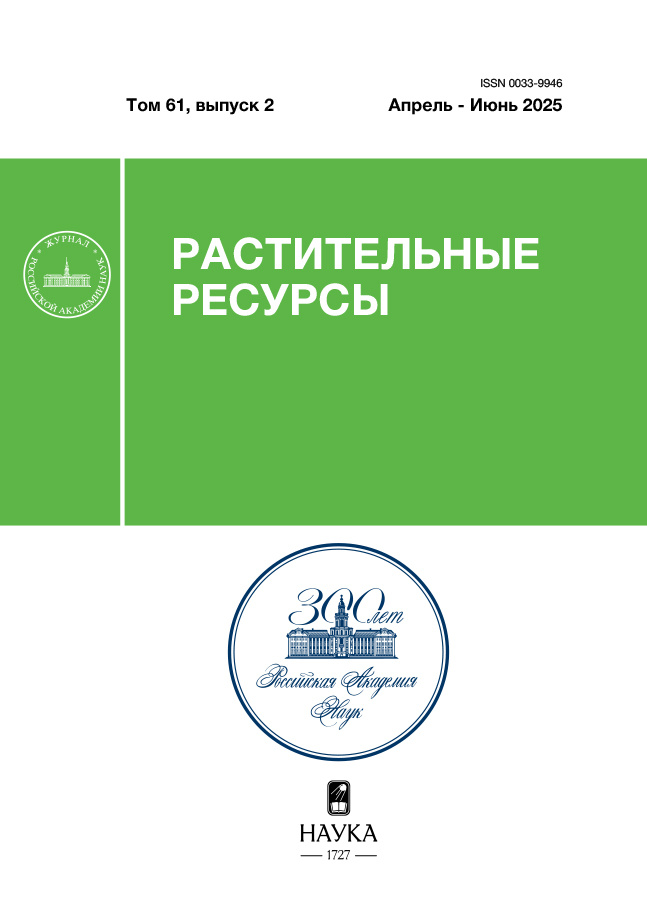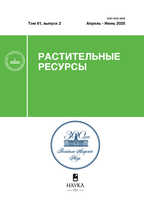Растительные ресурсы
Журнал «Растительные ресурсы» основан в 1965 г. и издается под руководством Отделения биологических наук РАН. Журнал включен в Перечень ведущих российских рецензируемых научных журналов ВАК, в которых должны быть опубликованы результаты диссертационных исследований на соискание ученых степеней доктора и кандидата наук.
Журнал «Растительные ресурсы» цитируется в базе данных Chemical Abstracts Service (CAS). С 2010 г. входит в систему РИНЦ, а с 2016 г. – в базу данных Russian Science Citation Index (RSCI) на платформе Web of Science. В журнале публикуются оригинальные статьи и обзоры в области биологии ресурсных видов растений, их компонентного состава и биологи-ческой активности, оценки растительных ресурсов различных групп дикорастущих полезных растений, режимов их эксплуатации и охраны, а также интродукции перспективных для использования видов.
Журнал предназначен для широкого круга ученых и специалистов, чьи профессиональные интересы включают вопросы ботаники, экологии, ресурсоведения, биогеоценологии.
Журнал «Растительные ресурсы» публикует оригинальные научные статьи по следующим направлениям исследований:
— растительные ресурсы отдельных стран, регионов, а также типов растительности и растительных формаций, различных категорий используемых природных угодий (кормовых, медоносных, ягодных и др.);
— ресурсы различных групп дикорастущих полезных растений (лекарственных, пищевых, кормовых, эфирномасличных, танидоносных и др.), режимы их эксплуатации и охраны;
— экология, биология, морфология и анатомия дикорастущих и интродуцированных растений – источников сырья и биологически активных соединений;
— популяционная структура видов дикорастущих ресурсных растений;
— первичная интродукция видов, имеющих практическую значимость;
— урожайность и семенная продуктивность дикорастущих и интродуцированных ресурсных растений;
— влияние антропогенных факторов на состояние растительных сообществ и популяций ресурсных видов растений;
— компонентный состав ресурсных видов, идентификация и структура природных соединений, их биосинтез, содержание, динамика накопления и химическая изменчивость;
— биологическая активность (фармакологические свойства, антибактериальная, антифунгальная, антиоксидантная и другие виды активности) экстрактов, их отдельных фракций или индивидуальных веществ, выделенных из растений.
Свидетельство о регистрации СМИ: ПИ № ФС 77 – 82786 от 04.03.2022
Текущий выпуск
Том 61, № 2 (2025)
ОБЗОРЫ
 3-20
3-20


Компонентный состав и биологическая активность экстрактов дикорастущих представителей семейства Rhamnaceae флоры России
Аннотация
В обзоре обобщены данные литературных источников о компонентном составе и биологической активности надземных и подземных частей 16 дикорастущих представителей семейства Rhamnaceae, распространенных на территории России. На исследованной территории встречаются виды четырех родов этого семейства (Rhamnus L., Ziziphus Mill., Paliurus Mill. и Frangula Mill.), три из которых представлены одним видом: Ziziphus jujuba Mill., Paliurus spina-cristi Mill. и Frangula alnus Mill. Данные хемосистематики не противоречат системе рода. За несколько десятилетий в надземных и подземных органах исследованных видов обнаружены opганические кислоты (яблочная, янтарная, винная), витамины (С, В1 и Р), алкалоиды, полифенолы, флавоноиды (рутин, гиперин, изокверцитрин и др.), цианидины, антрахиноны и стерины. Экстракты дикорастущих представителей семейства Rhamnaceae, а также отдельные их компоненты, проявляют разные виды биологической активности: противовирусную, противогрибковую, антибактериальную, противоопухолевую, противовоспалительную, ранозаживляющую, противодиабетическую и антиоксидантную. Плоды и кора представителей родов Rhamnus, Ziziphus, Paliurus и Frangula обладают слабительным, ранозаживляющим, умеренным противовоспалительным, вяжущим и бактерицидным действием. Плоды и экстракты Z. jujuba рекомендуют также для профилактики и лечения повреждений печени, ожирения, гипертонии и анемии, в составе сборов применяют для лечения инсульта и против вируса гриппа. Для трех кавказских и четырех сибирских и дальневосточных видов рода Rhamnus данные по компонентному составу и биологической активности, а также ресурсной базе, представлены очень скудно или отсутствуют. Обнаружены литературные сведения о компонентном составе и биологической активности надземных и подземных частей четырех родов и 12 видов семейства Rhamnaceae.
 21-39
21-39


Биологически активные соединения лекарственных растений, обладающие противогерпетическим действием (часть 2)
Аннотация
Во второй части обзора обобщены данные о противовирусной активности 26 лекарственных растений из 16 семейств в отношении вируса простого герпеса I или II типа. Показано, что активные соединения лекарственных растений, обладающие разными механизмами действия, способны эффективно подавлять развитие инфекции, вызванной вирусом простого герпеса.
 40-55
40-55


Грибные эндофиты растений как источники биологически активных веществ
Аннотация
Обзор посвящен грибам-эндофитам, мицелий которых существует в растениях бессимптомно. Они найдены и во всех других царствах эукариот. Отмечено, что культивирование грибов эндофитов может снизить нагрузку на ресурсы заготавливаемых лекарственных растений. Кратко охарактеризованы понятие «эндофиты» и их виды, история открытия, классификация, пути таксономического определения, возможность самостоятельного существования в виде плодовых тел вне растений, сообщества грибов эндофитов в одном растении, распространение в группах растений и их частях. Более подробно рассмотрены экологические аспекты взаимодействия с растениями – виды полезных эффектов для них и для грибов-эндофитов, разнообразие веществ, образуемых культурами грибов-эндофитов и их биологической активности. Показано, что в ряде случаев вещества, считающиеся активными основами лекарственных растений, образуются живущими в них грибами-эндофитами. Во многих случаях они образуют также и не выделявшиеся ранее из растений вещества с различными видами активности.
 56-64
56-64


РЕСУРСЫ ПОЛЕЗНЫХ РАСТЕНИЙ И РАСТИТЕЛЬНЫХ СООБЩЕСТВ
Изменчивость ресурснo-ценотических параметров Vaccinium vitis-idaea (Ericaceae) на возрастном градиенте культур сосняка мшистого (Pinetum pleuroziozum)
Аннотация
На территории западной Беларуси (заказник «Гродненская пуща») определены ресурсно-ценотические параметры (проективное покрытие, встречаемость, высота и урожайность побегов) ценопопуляций Vaccinium vitis-idaea L. в возрастном ряду культур сосняка мшистого (Рinetum pleuroziozum). Наиболее высокие значения урожайности побегов V. vitis-idaea от 9 до 54 г/м2 (возд.-сух.) наблюдали в 61–80-летних сообществах со сквозистостью древостоя 46–64%, в которых не проводились интенсивные лесохозяйственные мероприятия, кардинально изменяющие световой режим. По сквозистости сосняки мшистые дифференцируются на два больших кластера: 1) плотно сомкнутые 21–40-летние со сквозистостью 17–33% и низкими значениями ресурсно-ценотических параметров V. vitis-idaea (встречаемость – 36–76%, проективное покрытие – 1–5%, урожайность – 6–9 г/м2) и 2) умеренно-разреженные со сквозистостью 36–98%, включающие две подгруппы. Для умеренно разреженных сосняков мшистых, где не проводились рубки (I субкластер) со сквозистостью 46–64 % и после сплошной рубки (II субкластер) со сквозистостью 95–98% характерны максимальные значения ресурсно-ценотических параметров ценопопуляций V. vitis-idaea. В сообществах без рубки встречаемость составляла 100%, проективное покрытие – 20%, урожайность – 54 г/м2, в сообществах после сплошной рубки встречаемость – 100%, проективное покрытие – 7%, урожайность – 52 г/м2. Наиболее сильное влияние на ресурсно-ценотические параметры V. vitis-idaea оказывает резкая смена светового режима. При проведении рубок, которые приводят к возрастанию сквозистости >90%, мы рекомендуем лекарственное сырье V. vitis-idaea изымать в объеме эксплуатационного запаса в первые три года после проведения лесохозяйственных мероприятий. Использование лесотаксационной классификации древостоя (по классам возраста) повышает качество оценки недревесных ресурсов леса.
 65-80
65-80


БИОЛОГИЯ РЕСУРСНЫХ ВИДОВ
Устойчивость древостоев Fraxinus excelsior (Oleaceae) и Quercus robur (Fagaceae) в фрагментированных лесах Предволжья Республики Татарстан
Аннотация
Обсуждается устойчивость древостоев Quercus robur L. и Fraxinus excelsior L. в северо-восточной краевой части ареала на примере островного массива среднерусско-приволжских липово-дубовых с ясенем лесов Предволжья Республики Татарстан. Проанализирована динамика таксационных характеристик древостоев за шесть дат проведения государственного учета лесного фонда (1926, 1947, 1958, 1980, 2011, 2020 гг.). Показано, что в течение столетия виды изменяли свои фитоценотические стратегии. С помощью обобщенной линейной модели определены факторы, значимо связанные с этими изменениями. Общее для всех видов, произрастающих в краевой части ареалов, снижение устойчивости к неблагоприятным проявлениям климата в малолесном регионе усугубляется эффектами лесной фрагментации. В условиях островной изоляции лесных массивов Quercus robur теряет способность конкурировать и проявлять стратегию устойчивого эдификатора первого яруса при нарушении среды обитания из-за эксплуатации. Это обеспечивает второстепенным видам, в том числе Fraxinus excelsior, возможность перехода из ассектаторов в эдификаторы древостоя. Fraxinus excelsior проявляет избирательность к условиям рельефа и положению относительно границ лесного массива, что позволяет ему компенсировать лимитирующее влияние неблагоприятных проявлений климата. Но такую возможность могут предоставить только относительно крупные массивы леса, занимающие плоские водораздельные пространства, которых в условиях сильно освоенного, давно ставшего малолесным Предволжья практически нет.
 81-96
81-96


ИНТРОДУКЦИЯ РЕСУРСНЫХ ВИДОВ
Семенное размножение некоторых интродуцированных видов рода Onobrychis (Fabaceae) в полупустынной зоне Узбекистана
Аннотация
Статья посвящена особенностям семенного размножения четырех интродуцированных видов рода Onobrychis Mill. (O. micrantha Schrenk, O. pulchella Schrenk, O. chorassanica Bunge и O. seravchanica B. Fedtsch.) в полупустынной зоне на территории Республики Узбекистан. В условиях подгорной равнины однолетние виды O. micrantha и O. pulchella приступают к репродукции на 28–30-й день вегетации, а многолетние виды (O. chorassanica и O. seravchanica) – на втором году вегетации. Цветение и плодоношение на побеге происходит акропетально. У изученных видов преобладает аллогамия. Основными опылителями эспарцетов в полупустынных условиях являются пчелы из родов Andrena, Melitta, Anthophora и медоносная пчела (Apis mellifera). Отмечено наличие автотрипинга у однолетних видов O. micrantha и О. pulchella. Фертильность пыльцы изученных представителей рода Onobrychis довольно высокая (85.2–91.4%), а фертильность семязачатков составляет от 72.3 (O. seravchanica) до 87.2% (О. pulchella).
Созревание плодов изученных видов рода Onobrychis наблюдается в конце июля – начале августа. От начала вегетации до созревания плодов у однолетников проходит 58–68 дней, у O. chorassanica – от 114 до 123 дней, а у O. seravchanica – 126 дней до 131 дня. Потенциальная семенная продуктивность растений составляет от 57–68 (O. micrantha) до 689–816 (O. chorassanica) шт. семязачатков на побег, а реальная семенная продуктивность – от 12–19 (O. micrantha) до 132–152 (O. chorassanica) шт. семян на побег. Коэффицент семенной продуктивности, который является показателем адаптации растений к полупустынным условиям, у интродуцированных видов рода Onobrychis варьирует от 15 до 42%. Снижение реальной семенной продуктивности растений обусловлено воздействием комплекса абиогенных и биогенных факторов.
 97-108
97-108


СТРУКТУРА ПОПУЛЯЦИЙ РАСТЕНИЙ
Онтогенез, онтогенетическая структура и оценка состояния ценопопуляций Melilotus albus (Fabaceae) в Центральной Якутии
Аннотация
Melilotus albus Medic. (Fabaceae) был занесен в Якутию в начале XX века, встречается в центральной и южной частях Республики. В Центральной Якутии в онтогенезе M. albus выделено шесть онтогенетических состояний: se, p, j, im, v, g. Все изученные ценопопуляции нормальные, неполночленные. Преобладание генеративной группы особей в онтогенетических спектрах может отмечаться при отсутствии или небольшом воздействии антропогенной нагрузки на фоне достаточной увлажненности. Интенсивное антропогенное воздействие (выпас, скашивание) увеличивает долю виргинильных особей. При достаточном увлажнении под пологом леса повышается доля ювенильной группы особей. M. albus проявляет себя как пластичный вид – засухоустойчивый, теневыносливый, устойчивый к уплотнению почвы и вытаптыванию, а также к механическому повреждению. Благодаря накоплению кумаринов в генеративной фазе развития взрослые особи M. albus не поедаются лошадьми, но получают механические повреждения. Оценка состояния ценопопуляций показала, что увлажненность местообитаний и отсутствие антропогенной нагрузки являются основными факторами для успешного роста и развития M. albus. На увлажненных участках особи быстро набирают массу и подавляют рост и размножение других видов. Скашивание вызывает у особей M. albus уменьшение биометрических показателей даже при достаточном увлажнении местообитания.
 109-121
109-121


КОМПОНЕНТНЫЙ СОСТАВ РЕСУРСНЫХ ВИДОВ
Содержание антоцианов и дубильных веществ в надземных и подземных органах некоторых видов рода Geranium (Geraniaceae) Республики Бурятия
Аннотация
В статье представлены результаты исследований по изучению суммарного содержания антоцианов в сравнении с дубильными веществами пяти видов рода Geranium L. (Geranium pratense, G. sergievskajae, G. affine (= G. transbaicalicum subsp. turczaninovii), G. pseudosibiricum, G. eriostemon), произрастающих в условиях Республики Бурятии. Среднее содержание антоцианов в надземной части исследованных видов составляет 0.044–0.074% от массы абсолютно сухого сырья, в подземной части 0.031–0.058%, дубильных веществ – от 18 до 23% в надземной части и от 20 до 31% в подземной. Корреляция взаимного содержания антоцианов и дубильных веществ не выявлена.
 122-130
122-130













